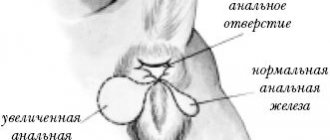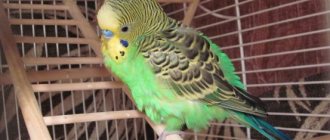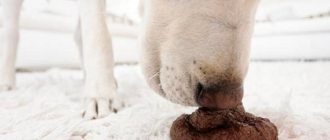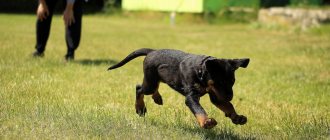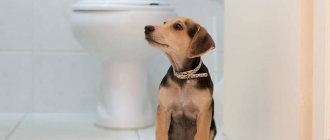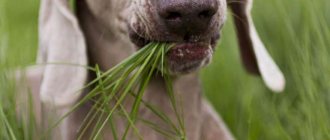If you've ever wondered, "Do dogs fart?", the answer is a resounding "yes!"
Every teacher has heard a strange dog fart. Just like us humans, gas in dogs can come in all shapes and sizes; some fart silently, some loudly, some have a bad smell of gas that you have to run away from the room! And there are those that disappear as quickly as they appeared - the ghostly fart...
Passing gas is just a part of your dog's life and there is no way to completely prevent it from happening. However, before you resign yourself to a life filled with endless, unbearable farts, there are ways to reduce their terrible smell and frequency.
And like us, a lot of it comes down to gut health and diet!
If your dog farts regularly, it could be a sign that something is wrong. But how do you know if there is cause for concern? We've looked into what causes these harsh sounds and looked at a few ways you can help reduce farting in dogs!
The mechanism of gas formation in the dog's intestines
Sources of repulsive phenomena, such as a dog farting, include the following factors:
- air absorption when eating quickly. An animal that is too hungry does not control the process and grabs large pieces;
- gases that are formed during bacterial hydrolysis - the process of processing and breaking down food;
- fermentation that occurs due to improper selection of feed, its low quality or expired shelf life;
- movement of air in the bloodstream into the intestinal tract.
Why does a dog fart
The mixture consists of 99% five components:
- nitrogen;
- oxygen;
- hydrogen;
- carbon dioxide;
- methane
The main composition does not have a specific odor; only 1% of the mixture gives it a repulsive aroma. Its ingredients include indole, ammonia, skatole, short-chain fatty acids and volatile amines: putrescine and cadaverine.
For your information! The volume of these volatile substances depends on the quality characteristics of the diet and intestinal microflora. Each section of the gastrointestinal tract forms a certain amount of them. Most of it occurs in the large intestine, which contains the largest number of microorganisms.
Bloated belly in a dog
The body eliminates gases in dogs through several ways:
- through the anus and mouth;
- by absorption of part into the systemic bloodstream and exit along with respiration;
- absorption by bacteria in the gastrointestinal tract.
For humans, up to 23 releases of a volatile mixture per day are permissible; there is no such data for dogs. Experts note that its volume in young and elderly animals is greater than in middle-aged dogs. The deviation occurs due to the unstable functioning of the digestive department.
Note! A healthy dog expels excess air during defecation or during increased physical activity (it may fart when jumping or suddenly changing body position).
Flatulence accompanies strong emotions - the dog’s joy at the sight of its owner or toy, fear. In contrast to this deviation, flatulence has characteristic symptomatic manifestations that are easy to notice.
Diet for gastrointestinal problems
Until recovery, dry and solid foods, fatty meat broths and animal proteins are excluded from the usual menu. The feeding regime is also changed. The dog is fed more often, but in smaller portions.
Further recommendations depend on the type of feeding:
- Ready-made feed. Instead of granules, they give wet canned food and meat pieces in packages. When changing your usual diet, it is important not to make a sudden transition. The finished food should be from a brand familiar to your pet.
- Natural products. The daily diet includes slimy porridge in water, boiled vegetables, well-cooked fish (only sea fish and without bones) and fermented milk products with a reduced percentage of fat content.
Please note that increased gas formation is caused by legumes, milk and most food from the human table. All these products are included in the prohibited list even for healthy four-legged animals. If this is your first time seeing this information, be sure to read the more complete list to protect your pet.
Frequent farting in a puppy
When purchasing puppies from professional nurseries, you need to pay attention to their physical condition. If the baby’s belly is swollen, and upon any palpation he begins to noticeably worry, whine, growl or bite, then the future pet has obvious intestinal dysfunction. In order not to have to deal with its treatment later, it is better to refuse the purchase.
A dog licks its anus under its tail: why does this happen?
Why does a puppy fart often:
- too early weaning;
- incorrect approach to artificial nutrition in the absence of a female or in her illness;
- constant malnutrition of the weaker puppy, which is pushed aside by larger and healthier brothers;
- Lactose intolerance - all dairy products.
If the puppy farts, squeals, shows his anxiety, and his stomach is rumbling and swollen, then he needs a light massage. After a correctly performed procedure, the baby calms down and relaxes. If, in addition to active gas formation, your pet begins to have diarrhea, then he needs to consult a veterinarian. Diarrhea at a young age quickly provokes dehydration and can cause death.
For your information! Miniature dogs of decorative breeds often suffer from similar bloating and weakness. Their anatomical structure provides for a minimal gastrointestinal section. When overfed, they experience various digestive disorders. To avoid these symptoms, when your Yorkie regularly farts after eating, you need to feed him in small portions.
Flatulence in a puppy
Final thoughts
Let's face it, dog farting is just a natural part of life and a common occurrence when you're a caregiver. The only time you need to worry is if these farts become an extremely regular and everyday occurrence. None of us want our dogs to be unhealthy, so find the cause of the problem as soon as possible. After all, our job is to make sure our pets are healthy, happy, and enjoying life with us—and that they have as few unpleasant odors as possible.
Article author: Becca Trigg . An all-around animal lover who absolutely loves writing and researching all things dog! Over the past few years, I have been able to gain extensive knowledge about pets; especially joint health and oral hygiene. When I'm not typing in the office, you can find me sitting in the village pub or growing chillies.
Causes of flatulence in adult dogs
Common primary sources of flatulence include complex carbohydrates, sometimes meat and low-quality offal. The latter contain a large percentage of phenols, indole and various sulfur derivatives. Under some conditions, gas formation in pets is caused by benign foods, but certain conditions must arise for this to happen.
Beans and soybeans
Shedding in dogs: why and when it happens
Legumes and soy cause active gas formation in both people and dogs. In many pets, the body is not able to digest and assimilate them normally. If you have been eating such foods from a young age, then over time the gastrointestinal tract gets used to and adapts to their consumption.
Note! Most of the problems involve dogs whose diet has been suddenly changed to include soy or legumes. The absence of a preparatory period and switching to dry biscuits with large volumes of vegetable protein lead to the indicated phenomena.
Gases and parasites
A variety of helminthiases and parvovirus infections are another source of active development of flatulence. Helminthic infestations rarely become a prerequisite for the formation of serious abnormalities in the digestive processes. Exceptions include cases when ignoring the mandatory prevention of parasites leads to the fact that their number exceeds the volume of food received.
Important! In addition to infection by parasitic organisms, the dog may begin to develop malignant tumors. Their aggressive effect on nearby tissues leads to destruction of the intestinal mucosa, serious digestive abnormalities and chronic flatulence.
Intestinal parasites of dogs
Probiotics
The completed course of treatment with antibacterial drugs provokes the death of not only harmful, but also beneficial microflora. Therapy is combined with probiotics, which help restore the balance of intestinal microorganisms. Timely intake of medications allows you to quickly get rid of active gas formation in the gastrointestinal tract and bloating.
Important! For dogs, it is better to buy products in liquid form. Why are such restrictions necessary? Studies have shown that tablet forms restore beneficial microflora more slowly due to the low content of symbionts in the capsules.
Eating on the street and overeating
Eating incontinence often becomes a source of problems for dogs. Some individuals cannot calmly pass by garbage containers and are engaged in eating waste. Such a diet causes fermentation of spoiled food and provokes a deviation when the dog farts very smellily.
The same effect occurs when feeding with leftovers from the master's table. If your dog is lactose intolerant, a small piece of cheese is enough to cause bloating in your dog. Veterinarians are categorically against any handouts; the pet’s diet should consist of products or food specially intended for it, and not human food.
Food incontinence in dogs
Allergy
An allergic reaction to cereals has been recorded in almost 60% of dogs. Attempts to feed them cereals lead to active gas formation with attempts to constantly “let the wind out.” The danger of this syndrome lies in the fact that the transition to normal food is difficult, and normalization of digestion does not occur in one day.
Note! Feeding a dog grains causes chronic bloating, constipation, and severe dysbiosis. A dog fed the wrong food often passes foul-smelling gas and suffers from indigestion with severe diarrhea.
Eating too fast
If your dog tends to eat his dinner quickly, this may be contributing to your dog's flatulence. In fact, the same is true for humans. Why does all this overeating lead to the appearance of buttocks after eating? This phenomenon is called aerophagia, where air enters the stomach while eating or drinking, and is one of the main causes of gas formation.
Try placing a tennis ball in the middle of your dog's plate to slow him down.
Forms of flatulence
The dog is vomiting yellow foam with liquid: why does this happen?
Why does my dog fart often? Animals, like their owners, have several types of deviations. Flatulence occurs in acute, delayed and chronic forms. With the last pronounced symptoms, there is no pathology, the general condition of the pet remains at the same level.
The latent course of the disease eventually leads to dysfunction of the pancreas and liver. Impaired functioning of the dog's organs provokes problems with digestion of food and causes increased bloating. The dog's belly begins to resemble a swollen drum. Veterinarians associate this condition with feeding, for example, Labradors and Spitz dogs, cheap industrial feeds based on legumes and soy.
Diarrhea in a dog
The acute course of the pathology is dangerous for the dog. It manifests itself:
- constant anxiety, frequent movement around the apartment;
- whining and trying to attract the owner’s attention;
- a tense and swollen abdomen;
- attacks of vomiting and diarrhea;
- deterioration of appetite, in difficult cases, complete refusal to eat;
- change in gum color to a grayish or bluish tint.
Important! If these clinical signs appear, the dog should be taken to a veterinarian. The clinic will conduct a diagnostic examination that will show the presence of intestinal pathologies and the qualitative characteristics of digestive enzymes.
What to do and how to help your pet
Flatulence is almost always a symptom and therefore cannot be treated as an independent disease. In order to help the dog, it is necessary to determine the root cause and treat it.
To alleviate the condition, dogs use a diet that is easily digestible and contains a small amount of fiber and fat.
If the veterinarian determines that the dog’s condition is chronic, in addition to diet, the pet is prescribed complex therapy. To quickly eliminate discomfort in a dog, special nutritional supplements are used, including those containing probiotics.
Symptoms accompanying flatulence
The accumulation of a large amount of air in the dog’s gastrointestinal tract leads to disruptions in its functioning and causes pain of varying severity. Common symptomatic manifestations of abnormal bowel function include:
- visible increase in volume of the dog’s abdominal cavity;
- excretion of excess through the oral cavity, with parallel hiccups, fetid aromas and attacks of vomiting;
- problems with bowel movements. The animal suffers from constipation or loose stools;
- frequent and loud excretion through the rectum with a sour, putrid or repulsive odor, reminiscent of the decomposition of rotten eggs;
- regular gurgling and rumbling;
- decreased appetite or attempts to refuse food;
- non-standard pose of the pet - constantly hunched over;
- unreasonable anxiety of the dog and search for a comfortable position;
- a sharp decrease in body weight.
Gas formation leads to increased pressure on the intestinal walls with irritation of receptors and pain. When a bolus of food is mixed with gases, foam forms, which covers the internal walls of the organ, causing poor absorption of nutrients. Long-term illness provokes metabolic problems, exhaustion and weight loss in the pet.
The constant presence of a gas mixture in the gastrointestinal tract causes inflammation of the mucous membranes and spasms in the dog. The pathological form of flatulence can become a source of:
- elevated temperature;
- the appearance of particles of blood, pus or mucus in stool and urine.
Important! Some animals may shed eggs and adult parasites in their waste products. Without special therapy, recovery is impossible.
Diseases accompanied by the release of gases
Diseases accompanied by the release of gases are very common and numerous, but in most cases they are associated with nutrition and care.
First, you need to make sure that the dog is suffering from flatulence:
- Your dog farts regularly, and the gas may be odorless or cause severe discomfort.
- The dog experiences abdominal discomfort.
- The pet has abdominal distension.
- You notice that your pet's stomach often growls.
With flatulence, the dog may experience associated problems that are expressed by various symptoms.
Reasons to contact a veterinarian
If your dog farts constantly, and each act is accompanied by a repulsive aroma, then he needs a visit to the veterinary clinic. The doctor conducts a visual and palpation examination, based on the results of which further diagnostics are prescribed. The pet will have to undergo tests for dysbiosis, parasites and blood. In difficult cases, an ultrasound of the gastrointestinal tract is performed, and based on the results of the studies, therapy is prescribed.
Examination at a veterinary clinic
A visit to the clinic with a dog is necessary:
- with severe pain syndrome;
- the appearance of foreign particles in feces;
- elevated body temperature.
Important! Ignoring signs of disease and believing that the animal is normal can lead to serious consequences, including the death of the pet.
Probiotics
The main problem with bloating is the death of beneficial intestinal microflora, without which the dog will not have normal digestion in principle. The only way out is to repopulate the intestines with “positive” microbes . This can be done by giving your dog probiotics. The name of this group of drugs is made up of two words. “Pro” - which means “for”, and also “bios”, which means life. Simply put, these are medicines “for life”. More precisely, they contain colonies of beneficial symbiotic microorganisms. Even giving them to your pet once can significantly alleviate his condition with dysbacteriosis and severe bloating.
One note - probiotics should only be purchased in liquid form. Studies have shown that drugs produced in capsule form contain a maximum of 2-5% of living microorganisms.
Preventing bloating in animals
In order for an animal to stop constantly farting, you must adhere to the following rules:
- normalize nutrition by purchasing good quality food that fully meets the needs of the dog’s body;
- when feeding naturally, reduce the amount of incoming vegetable protein (cereals and legumes), give preference to fermented milk products and beef;
- refuse handouts from your table. Any confectionery, sweets and other delicacies are strictly prohibited;
- increase the pet’s motor and physical activity: walk, play with him longer, do not let him lie down all the time;
- carry out timely prevention of helminths;
- regularly visit the veterinarian for examinations of the animal’s condition;
- If you have a habit of picking up waste, walk him only with a muzzle.
The right choice of diet, timely replenishment of the intestinal microflora with probiotics, frequent walks and timely visits to the veterinary clinic will help reduce the risk of developing flatulence with regular spoilage of the air in the house by foul winds. Ignoring the basic rules of caring for pets can become the root cause of the development of a chronic form of pathology and other serious damage to the gastrointestinal tract.
Risk groups by breed
In most cases, large, barrel-chested breeds suffer from bloat. This feature is typical for:
- St. Bernards;
- Dobermans;
- Labradors;
- German Shepherds;
- Rottweilers;
- Great Danes;
- standard (royal) poodles;
- golden retrievers;
- bobtails.
In addition to breed predisposition, there is a relationship with age. The diseases listed above are usually diagnosed in animals over 7 years of age, suffering from chronic pathologies and leading a “sofa” lifestyle.
